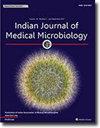Effect of electric current in viability, biofilm formation and antibiotic resistance of Pseudomonas aeruginosa: A systematic review
IF 1.4
4区 医学
Q4 IMMUNOLOGY
引用次数: 0
Abstract
Background
The bactericidal effect of electric current has been studied in various microorganisms such as Pseudomonas aeruginosa. The objective of this review is to identify the experimental parameters with the greatest antibacterial effect in the shortest time.
Methods
Literature search was conducted in the databases PubMed, Science Direct, and Google Scholar. Only original articles published between 2014 and 2023 were included, where the effect of electric current on viability, biofilm formation, and/or antibiotic resistance in P. aeruginosa was analyzed. Quality control criteria considered included specifying control and experimental groups, replicates performed, experimental parameters, and study limitations.
Results
Ten studies were included, which involved the strains Xen5, Xen41, PAO1 persistent cells, and PA14. An average reduction of 3.5 log in biofilm formation was observed in the included studies. The electric current parameters that achieved the greatest effect were 500 μA DC with platinum electrodes for 4 days [5.2–5.5 log], 200 μA intermittent with titanium electrodes for 4 days [4.99 log], and 150 ± 60 μA with silver electrodes for 24 h [4 log]. Complete eradication of PAO1 persistent cells was achieved in 1 h with a treatment of 70 μA/cm2 DC followed by 1.5 μg/mL tobramycin for 1 h each.
Conclusions
The bactericidal effect of electric current is proportional to the exposure time and current intensity. The electrode material influences the effectiveness of the treatment, possibly because of redox reactions, while differences are observed in the effect on the cell membrane and gene expression when using metallic or carbon electrodes, suggesting differences in the mechanism of action.
电流对铜绿假单胞菌活力、生物膜形成和抗生素耐药性的影响:系统综述。
背景:电流的杀菌效果已在铜绿假单胞菌等多种微生物中进行了研究。本综述旨在确定在最短时间内具有最大抗菌效果的实验参数:方法:在 PubMed、Science Direct 和 Google Scholar 数据库中进行文献检索。仅纳入 2014-2023 年间发表的原创文章,这些文章分析了电流对铜绿假单胞菌的活力、生物膜形成和/或抗生素耐药性的影响。考虑的质量控制标准包括说明对照组和实验组、进行的重复、实验参数和研究限制:结果:共纳入 10 项研究,涉及菌株 Xen5、Xen41、PAO1 持久细胞和 PA14。在这些研究中,生物膜的形成平均减少了 3.5 log。效果最好的电流参数是:使用铂电极的 500 μA 直流电,持续 4 天 [5.2-5.5 log];使用钛电极的 200 μA 间歇电流,持续 4 天 [4.99 log];使用银电极的 150 ± 60 μA 电流,持续 24 小时 [4 log]。用 70 μA/cm2 直流电处理 PAO1 顽固细胞 1 小时后,再用 1.5 μg/mL 妥布霉素各处理 1 小时,即可完全清除:结论:电流的杀菌效果与暴露时间和电流强度成正比。电极材料影响治疗效果,可能是因为氧化还原反应,而使用金属电极或碳电极对细胞膜和基因表达的影响存在差异,表明作用机制不同。
本文章由计算机程序翻译,如有差异,请以英文原文为准。
求助全文
约1分钟内获得全文
求助全文
来源期刊

Indian Journal of Medical Microbiology
IMMUNOLOGY-
CiteScore
2.20
自引率
0.00%
发文量
154
审稿时长
73 days
期刊介绍:
Manuscripts of high standard in the form of original research, multicentric studies, meta analysis, are accepted. Current reports can be submitted as brief communications. Case reports must include review of current literature, clinical details, outcome and follow up. Letters to the editor must be a comment on or pertain to a manuscript already published in the IJMM or in relation to preliminary communication of a larger study.
Review articles, Special Articles or Guest Editorials are accepted on invitation.
 求助内容:
求助内容: 应助结果提醒方式:
应助结果提醒方式:


